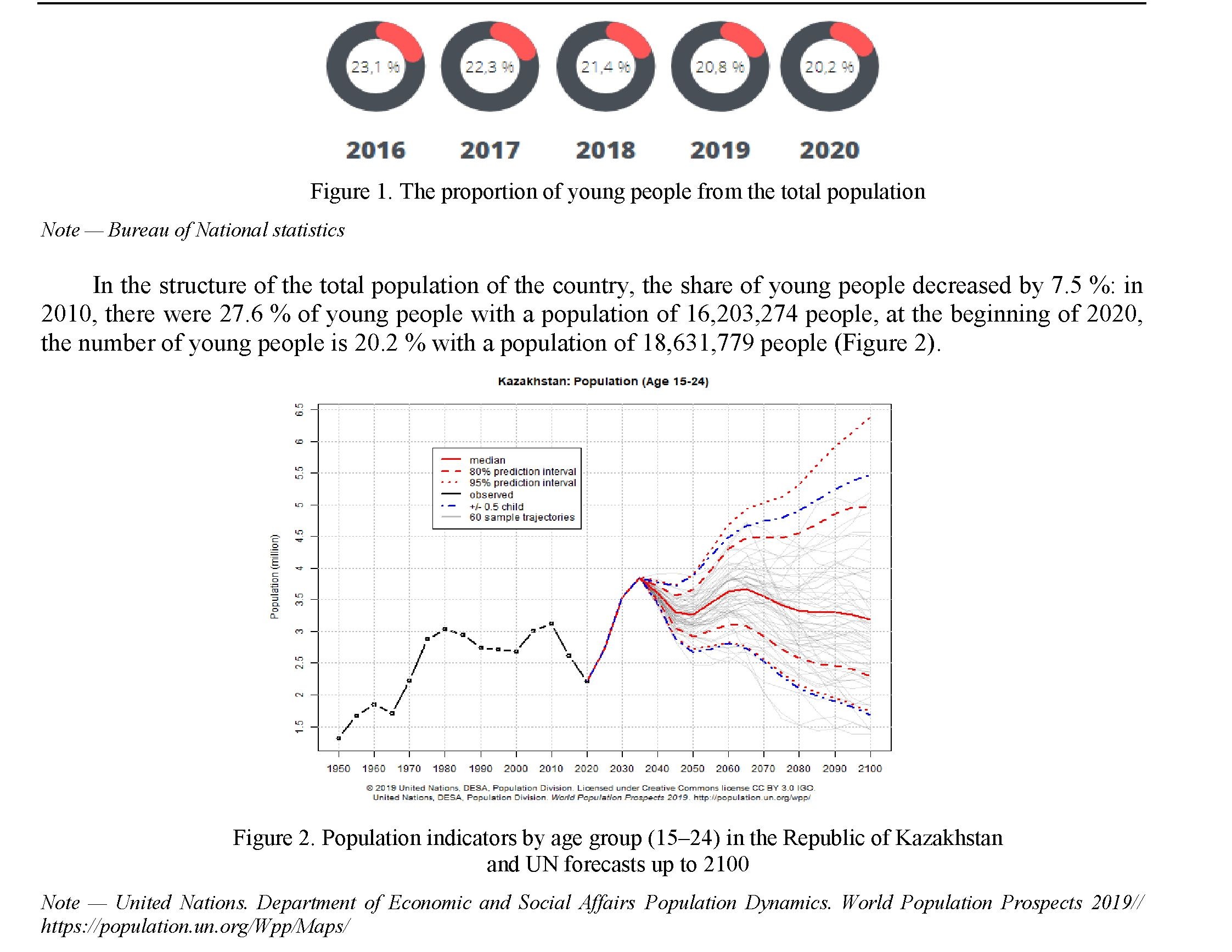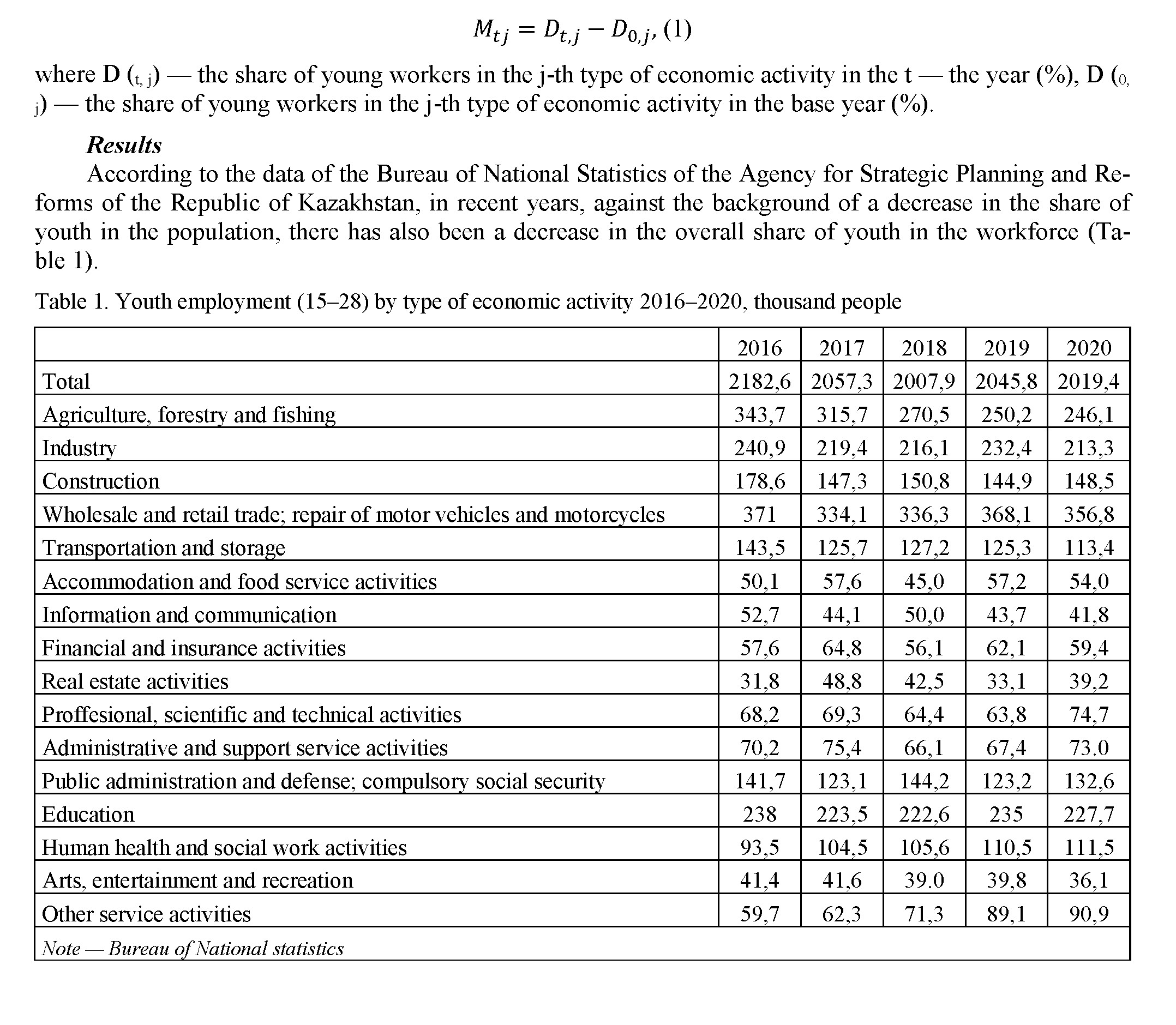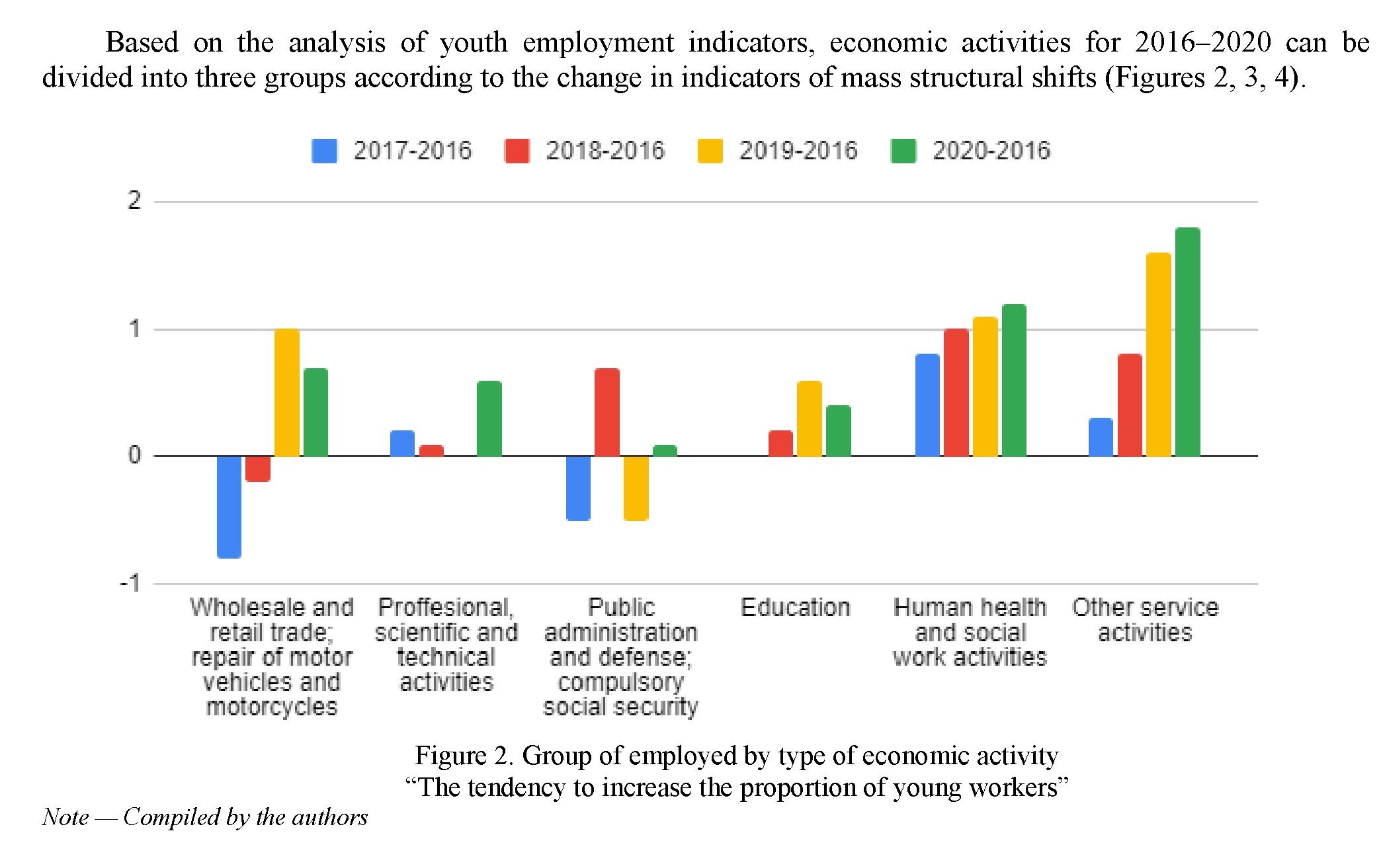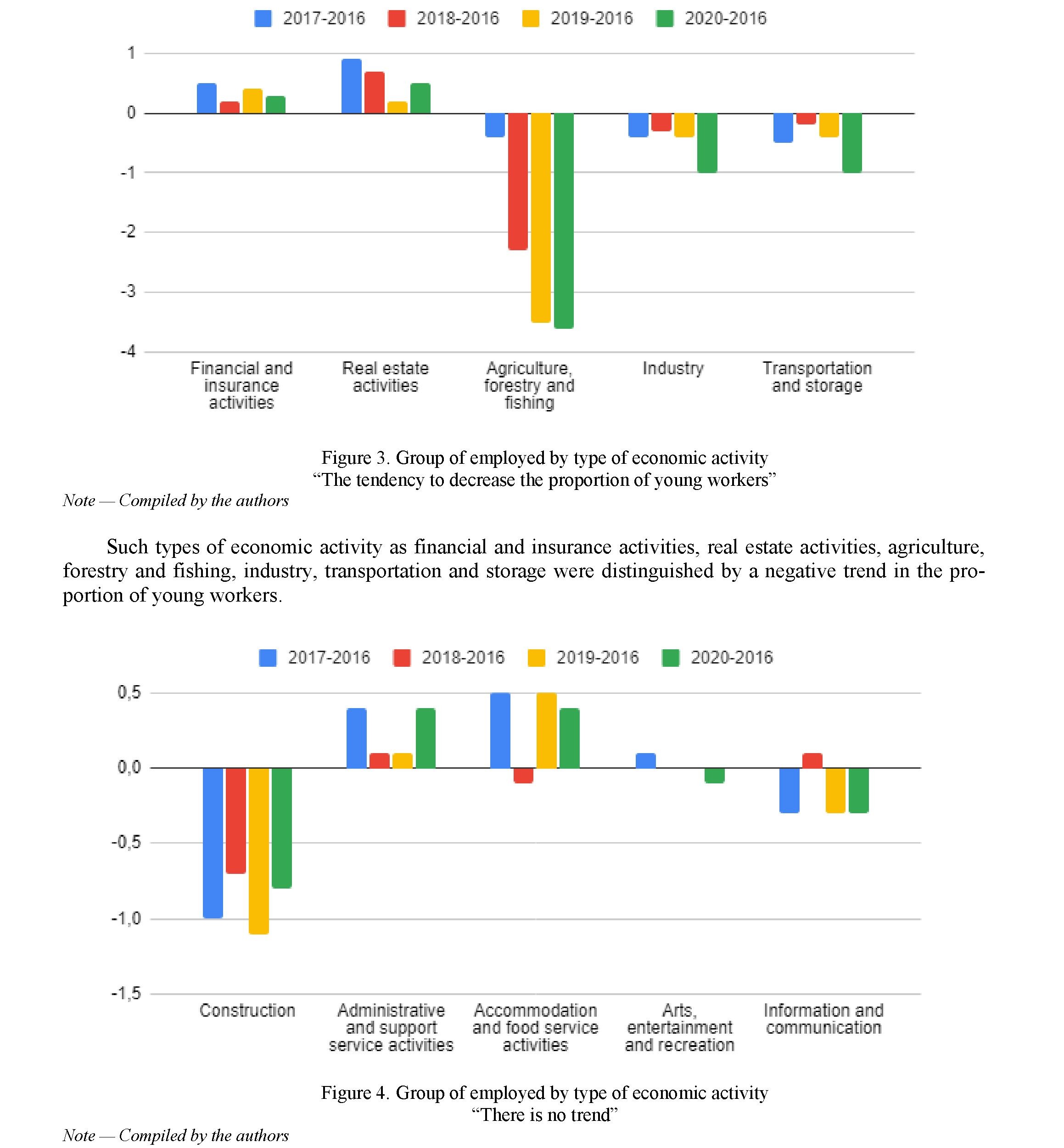Abstract
Object: Based on the assessment of structural changes in youth employment in Kazakhstan to identify favorable industries for the development of the labor activity of young workers.
Methods: Methods of system, dynamic and structural analysis, estimates of the mass of structural shifts have been used.
Results: The results of the analysis of changes in structural shifts in youth employment facilitated to identify the most favorable industries in the labor activity of this age group: agriculture, forestry and fisheries, professional, scientific and technical activities, public administration and defense, compulsory social security, education, human health and social work activities, other service activities.
Conclusions: Based on statistical data on the employment of the population aged 15–28 years in Kazakhstan, favorable industries for the continuation of youth work have been identified. Measures of state support for youth employment can be aimed at the identified industries as favorable for youth work in the future, thereby reducing youth unemployment and NEET-youth indicators.
Introduction
In any country, the problem of youth employment, on the one hand, closely depends on the general situation in the field of employment, its quantitative and qualitative parameters. If the priorities of macroeconomic and social policy do not include productive employment, and the aggregate demand for labor does not grow, it is impossible to successfully implement any programs for the integration of young people into labor markets. On the other hand, the youth labor market has its own specifics. Age-related obstacles to the transition of girls and boys from study to work life include the following: lack of work experience; strict rules for regulating the labor market; the discrepancy between the skills and aspirations of young people and the realities of demand in the labor market; obstacles to entrepreneurship and self-employment; lack of organization and opportunities for representation of interests, which means there is a small number of channels through which young people could pay attention to their needs and problems (ILO, Resource platform “Decent work for sustainable development”).
The issues of employment of the younger generation are of particular relevance in the modern conditions of the labor market functioning and the regulation of labor relations. This group in Kazakhstan, according to the Law of the Republic of Kazakhstan dated February 9, 2015 No. 285-V ZRK “On State Youth Policy” includes persons aged 14 to 29 years (the Law of the Republic of Kazakhstan “On State Youth Policy”).
In the demographic structure of the population of Kazakhstan, a number of young people under the age of 29 has been declining in recent years. The reduction in the number of young residents of Kazakhstan is the result of the “demographic pit” of the 90s (National Report “Youth of Kazakhstan 2020”). Over the past 10 years, a number of young people in the country has decreased by 16.3 % (Figure 1). Despite the fact that the share of young people in the total population of Kazakhstan is decreasing, the number of children and adolescents is increasing, which indicates the need to solve the problem of employment of young people.
The UN demographic projections are based on probabilistic projections of total fertility and life expectancy at birth (United Nations. Department of Economic and Social Affairs Population Dynamics. World Population Prospects, 2019). It is expected that the proportion of young people in the country will increase significantly as a result of the stable trend of increasing fertility since the early 2000s. It is expected that the peak number of young people will reach by 2030.
Young people are the main source and determining engine of social and economic development in the present and future. Thus, the main question of our consideration arises whether there have been changes in the employment of young people in the labor market of Kazakhstan.
Literature Review
Scientists and researchers pay a considerable attention to the issue of employment of the young population.
Thus, on the basis of study of N.S. Blinova and D.V. Sokolov, the youth labor market is characterized by us as a specific segment of labor relations with a number of features, among which we highlight the difficulties of adaptation of young employees: problems of professional orientation; low material security and housing problems. Youth as an age group in the labor market has significant differences from other population groups — it is the most promising category of the economically active population, which is at the stage of formation, the most mobile and ready for change, with career opportunities and the prospect of a long period of work (Blinova & Sokolov, 2016).
As noted by Zabelina O.V. and others, the global crisis complicates the situation of young people in the labor market, since young people are more likely to be in temporary and part-time employment, which means they are more likely to face a high risk of losing their jobs and earnings. The COVID-19 pandemic


43
has “pushed” many young people aged 18–29 into unemployment, and besides, younger workers (compared to people aged 30–34) tend to stop working (Zabelina, 2021).
Based on the qualitative analysis of measures and quantitative analysis by countries and youth employment programs, G.A. Krasnova highlights that education and training are the dominant measure (event) in youth employment programs (Krasnova, 2015).
Thus, the works of scientists devoted to the analysis of youth employment in the labor market cover a wide range of issues. Nevertheless, the analysis of structural shifts in the employment of young workers in Kazakhstan has not been sufficiently studied.
Methods
The official datas of the Bureau of National Statistics of the Agency for Strategic Planning and Reforms of the Republic of Kazakhstan and the UN Department of Economic and Social Affairs of the Population were used for the analysis (Gazizova et al., 2021). Due to the specifics of the methodological calculations of the statistical service, the employed youth from 15 to 29 years old was chosen as the object of the research.
The methods of dynamic and structural analysis were used in the processing of statistical and departmental data describing the quantitative parameters of the participation of the youth in the labor market in Kazakhstan (Kalabina et al., 2021).
Methods of assessment of structural changes involve the calculation of the masses of structural shifts in economic activity, which was calculated by the formula (Sarycheva, 2017):
The most popular types of economic activity among young people in 2020 are wholesale and retail trade (17.7 %), education, agriculture, forestry and fisheries (12.2 %), education (11.3 %), industry (10.6 %). That is, young specialists are mainly employed in low-productive industries (Table 2).
Table 2. Share of young workers (15–28) by type of economic activity 2016–2020, %
|
2016 |
2017 |
2018 |
2019 |
2020 |
|
|
Agriculture, forestry and fishing |
15,7 |
15,3 |
13,5 |
12,2 |
12,2 |
|
Industry |
11,0 |
10,7 |
10,8 |
11,4 |
10,6 |
|
Construction |
8,2 |
7,2 |
7,5 |
7,1 |
7,4 |
|
Wholesale and retail trade; repair of motor vehicles and motorcycles |
17,0 |
16,2 |
16,7 |
18,0 |
17,7 |
|
Transportation and storage |
6,6 |
6,1 |
6,3 |
6,1 |
5,6 |
|
Accommodation and food service activities |
2,3 |
2,8 |
2,2 |
2,8 |
2,7 |
|
Information and communication |
2,4 |
2,1 |
2,5 |
2,1 |
2,1 |
|
Financial and insurance activities |
2,6 |
3,1 |
2,8 |
3,0 |
2,9 |
|
Real estate activities |
1,5 |
2,4 |
2,1 |
1,6 |
1,9 |
|
Proffesional, scientific and technical activities |
3,1 |
3,4 |
3,2 |
3,1 |
3,7 |
|
Administrative and support service activities |
3,2 |
3,7 |
3,3 |
3,3 |
3,6 |
|
Public administration and defense; compulsory social security |
6,5 |
6,0 |
7,2 |
6,0 |
6,6 |
|
Education |
10,9 |
10,9 |
11,1 |
11,5 |
11,3 |
|
Human health and social work activities |
4,3 |
5,1 |
5,3 |
5,4 |
5,5 |
|
Arts, entertainment and recreation |
1,9 |
2,0 |
1,9 |
1,9 |
1,8 |
|
Other service activities |
2,7 |
3,0 |
3,6 |
4,4 |
4,5 |
|
Note — Compiled by the authors |
To identify industries with a high potential for growth in the level of youth employment, a structural analysis of the economy was carried out from the position of employment by type of economic activity. For this purpose, the mass of the structural shift is defined as the difference in the share of the structural indicator (the share of young workers for each type of economic activity) in the current period and the share of the same indicator in the base period (2016) (Table 3).
Table 3. Dynamics of the mass of structural shifts in 2016–2020 in Kazakhstan, %
|
2017–2016 |
2018–2016 |
2019–2016 |
2020–2016 |
|
|
1 |
2 |
3 |
4 |
5 |
|
Total |
-125,3 |
-174,7 |
-136,8 |
-136,2 |
|
Group of employed by type of economic activity “The tendency to increase the proportion of young workers” |
||||
|
Wholesale and retail trade; repair of motor vehicles and motorcycles |
-0,8 |
-0,2 |
1,0 |
0,7 |
|
Proffesional, scientific and technical activities |
0,2 |
0,1 |
0,0 |
0,6 |
|
Public administration and defense; compulsory social security |
-0,5 |
0,7 |
-0,5 |
0,1 |
|
Education |
0,0 |
0,2 |
0,6 |
0,4 |
|
Human health and social work activities |
0,8 |
1,0 |
1,1 |
1,2 |
|
Other service activities |
0,3 |
0,8 |
1,6 |
1,8 |

45
|
1 |
2 |
3 |
4 |
5 |
|
Group of employed by type of economic activity “The tendency to decrease the proportion of young workers” |
||||
|
Financial and insurance activities |
0,5 |
0,2 |
0,4 |
0,3 |
|
Real estate activities |
0,9 |
0,7 |
0,2 |
0,5 |
|
Agriculture, forestry and fishing |
-0,4 |
-2,3 |
-3,5 |
-3,6 |
|
Industry |
-0,4 |
-0,3 |
0,3 |
-0,5 |
|
Transportation and storage |
-0,5 |
-0,2 |
-0,4 |
-1,0 |
|
Group of employed by type of economic activity “There is no trend” |
||||
|
Construction |
-1,0 |
-0,7 |
-1,1 |
-0,8 |
|
Administrative and support service activities |
0,4 |
0,1 |
0,1 |
0,4 |
|
Accommodation and food service activities |
0,5 |
-0,1 |
0,5 |
0,4 |
|
Arts, entertainment and recreation |
0,1 |
0,0 |
0,0 |
-0,1 |
|
Information and communication |
-0,3 |
0,1 |
-0,3 |
-0,3 |
|
Note — Compiled by the authors |
||||
Thus, the group where the dynamics of the growth of the share of youth employment was observed including industries related to agriculture, forestry and fisheries, professional, scientific and technical activities, public administration and defense, compulsory social security, education, human health and social work activities, and other service activities.
In 5 types of economic activity, the proportion of employed youth remained practically unchanged: construction, administrative and support service activities, accommodation and food service activities, arts, entertainment and recreation, information and communication.
Discussions
The youth segment of the labor market is part of the economic system experiencing the changes in the economy, in particularly, in the conditions of the coronavirus pandemic. As a result of the situation that has

developed due to COVID–19, it has complicated the issues of employment among young people. The main problem is the employment of young people, which is currently relevant for the labor market, but in conditions of increasing imbalance of supply and demand, they become extremely acute (Olenchenko & Gorchakova, 2021).
The youth labor market has its own specific features. It is characterized by the instability of supply and demand, which is due to the variability of professional orientations of young people and socio-professional uncertainty. The situation is aggravated by the complicated social problems of young people associated with a fundamental change in socio-cultural and political conditions of personal development, entailing increasing difficulties in self-determination of young people professionally. Secondly, the youth labor market is characterized by low competitiveness compared to other age groups. Young people are at high risk of losing their jobs or not finding a job. Employment opportunities for new labor entering the labor market are declining (Lopatkin, 2015).
Thus, issues in the field of employment and youth employment are among the key problems of the modern labor market (Yakovleva, 2016).
Conclusions
The results of the analysis of changes in structural shifts in youth employment helped to identify the most favorable industries in the labor activity of this age group:
- agriculture, forestry and fisheries;
- professional, scientific and technical activities;
- public administration and defense;
- compulsory social security;
- education;
- human health and social work activities;
- other service activities.
The coronavirus pandemic has changed all aspects of life. Before the crisis caused by COVID–19, social and economic involvement of young people were on the spectrum of important issues. Thus, it is necessary to take measures aimed at encouraging young people into the workforce, otherwise young people will suffer from serious and long-term consequences of the pandemic (Petrochenko, 2018).
State support measures for youth employment can be focused on these industries as positive in the work of young people in the future, thereby reducing youth unemployment and NEET-youth indicators (Khusainova et al., 2021).
Acknowledgements
This research is funded by the Science Committee of the Ministry of Education and Science of the Republic of Kazakhstan (Grant No. AP09259065).
References
- National Report “Youth of Kazakhstan — 2020”. eljastary.kz. Retrieved from
- https://eljastary.kz/upload/iblock/887/887f8cc33592605699c33a49096c91a2.pdf
- Blinova, N.S. & Sokolov, D.V. (2016). Problemy molodezhnoi zaniatosti na regionalnom rynke truda [Problems of youth employment in the regional labor market]. Vestnik Rossiiskogo universiteta kooperatsii — Vestnik of the Russian University of Cooperation, 2 (24), 18–20 [in Russian].
- Data of Agency for Strategic planning and reforms of the Republic of Kazakhstan Bureau of National statistics. Retrieved from https://stat.gov.kz/
- Department of Economic and Social Affairs Population Dynamics of UN. Retrieved from https https://population.un.org
- Gazizova, M.R., Khussainova, Zh.S., & Vechkinzova, Y.A. (2021). The impact of the working longevity of the “silver generation” on the Kazakhstani labor market. Bulletin of the Karaganda University. Economy Series. DOI 10.31489/2021Ec1/48–56
- ILO, Resource platform “Decent work for sustainable development”. www.ilo.org. Retrieved from https://www.ilo.org/moscow/dw4sd/themes/youth-employment/lang—ru/index.htm
- Kalabina, E.G., Gazizova, M.R., & Khusainova, Zh.S. (2021). Strukturnaia dinamika zaniatosti naseleniia starshego vozrasta stran–uchastnits Evraziiskogo yekonomicheskogo soiuza [Structural dynamics of employment of the older population of the member countries of the Eurasian Economic Union] // Yekonomika regiona — Economy of the region, 17, 3, 842–854 // https://doi.org/10.17059/ekon.reg.2021, 3–9 [in Russian].
- Khusainova, Zh.S., Adilova, Zh.G., Bektleeva, D.E., Abauova, G.M., & Gazizova, M.R. (2021). Teoretiko- metodologicheskie osnovy issledovaniia NEET-molodezhi v kontekste bibliometricheskogo analiza [Theoretical and methodological foundations of NEET-youth research in the context of bibliometric analysis] // Yekonomika i predprinimatelstvo — Economics and Entrepreneurship, 7 (132), 1349–1355. doi: 10.34925/EIP.2021.132.7.246 [in Russian].
- Khusainova, Zh.S., Zhartay, Zh.M., Abauova, G.M., Lambekova, A.N., & Syzdykova D.I. (2021). The nature of the NEET youth segment, its features and parameters in both domestic and global conditions. Bulletin of the Karaganda University. Economy Series, No. 3 (103)/ p, 40–53. doi 10.31489/2021Ec3/40–53
- Krasnova, G.A. (2015). Analiz mezhdunarodnogo opyta povysheniia zaniatosti i snizheniia bezrabotitsy sredi mo- lodezhi [Analysis of international experience in increasing employment and reducing youth unemployment]. NOMOTHETIKA: Filosofiia. Sotsiologiia. Pravo – Philosophy. Sociology. Right, 33 (14 (211)), 165–178 [in Russian].
- Zakon Respubliki Kazakhstan «O gosudarstvennoi molodezhnoi politike». adilet.zan.kz Retrieved from https://adilet.zan.kz/rus/docs/Z1500000285 [in Russian].
- Lopatkin, I.V. (2015). Molodezhnyi segment rynka truda Saratovskoi oblasti: adaptatsiia k sovremennym realiiam i stabilnost [The youth segment of the Saratov region labor market: adaptation to modern realities and stability] // Izvestiia Saratovskogo universiteta. Novaia seriia. Seriia Sotsiologiia. Politologiia — Bulletin of Saratov University. New series. Series: Sotsiology. Politology. Retrieved from: https://cyberleninka.ru/article/n/molodezhnyy-segment- rynka-truda-saratovskoy-oblasti-adaptatsiya-k-sovremennym-realiyam-i-stabilnost [in Russian].
- Olenchenko, V.O., & Gorchakova, M.V. (2021). Osobennosti molodezhnogo segmenta rynka truda v subektakh Rossi- iskoi Federatsii [Features of the youth segment of the labor market in the subjects of the Russian Federation]. Vse- rossiiskaia nauchnaia konferentsiia molodykh issledovatelei s mezhdunarodnym uchastiem «Yekonomika segodnia: sovremennoe sostoianie i perspektivy razvitiia» («Vektor – 2021»): sbornik materialov / Ministerstvo nauki i vysshego obrazovaniia Rossiiskoi Federatsii; Rossiiskii gosudarstvennyi universitet im. A.N. Kosygina (Tekhnologii. Dizain. Iskusstvo). Chast 4. — Moscow: FGBOU VO «RGU im. A.N. Kosygina», 63–65. Retrieved from https://kosygin-rgu.ru/filemanag/Uploads/news/24–05–
- 2021/%D0 %92 %D0 %B5 %D0 %BA%D1 %82 %D0 %BE%D1 %80–
- 2021 %20 %D0 %A7 %D0 %B0 %D1 %81 %D1 %82 %D1 %8C%204.pdf [in Russian].
- Petrochenko, A.A. (2018). Problemy zaniatosti molodezhi stran Evraziiskogo yekonomicheskogo soiuza [Problems of youth employment in the countries of the Eurasian Economic Union] // Vestnik Volgogradskogo gosudarstvennogo universiteta. Seriia 3. Yekonomika |Yekologiia — Journal of Volgograd State University. Economics. 1. Retrieved from: https://cyberleninka.ru/article/n/problemy-zanyatosti-molodezhi-stran-evraziyskogo-ekonomicheskogo-soyuza [in Russian].
- Sarycheva, T.V. (2017). Metodologiia kompleksnogo statisticheskogo analiza zaniatosti v Rossiiskoi Federatsii po vidam yekonomicheskoi deiatelnosti [Methodology of comprehensive statistical analysis of employment in the Russian Federation by type of economic activity]: Candidate’s thesis. Moscow [in Russian].
- Yakovleva, O.S. (2016). Problemy zaniatosti molodezhi v Respublike Sakha (Yakutiia) (na primere vypusknikov Severo-Vostochnogo federalnogo universiteta im. M.K. Ammosova) [Youth employment problems in the Republic of Sakha (Yakutia) (by the example of graduates of “Ammosov North-Eastern Federal University”)]. Yekonomika truda — Labour economics, 3 (4), 325–330. doi: 10.18334/et.3.4.36955 [in Russian].
- Zabelina, O.V., Asaliev, A.M., & Druzhinina, E.S. (2021). Problemy molodezhnogo segmenta rossiiskogo rynka truda i novye aktsenty politiki podderzhki zaniatosti molodezhi [Problems of the youth segment of the Russian labour market and novelties of the youth employment policy]. Yekonomika truda — Labour economics, 8 (9) 985–1002. doi: 10.18334/et.8.9.113473 [in Russian].